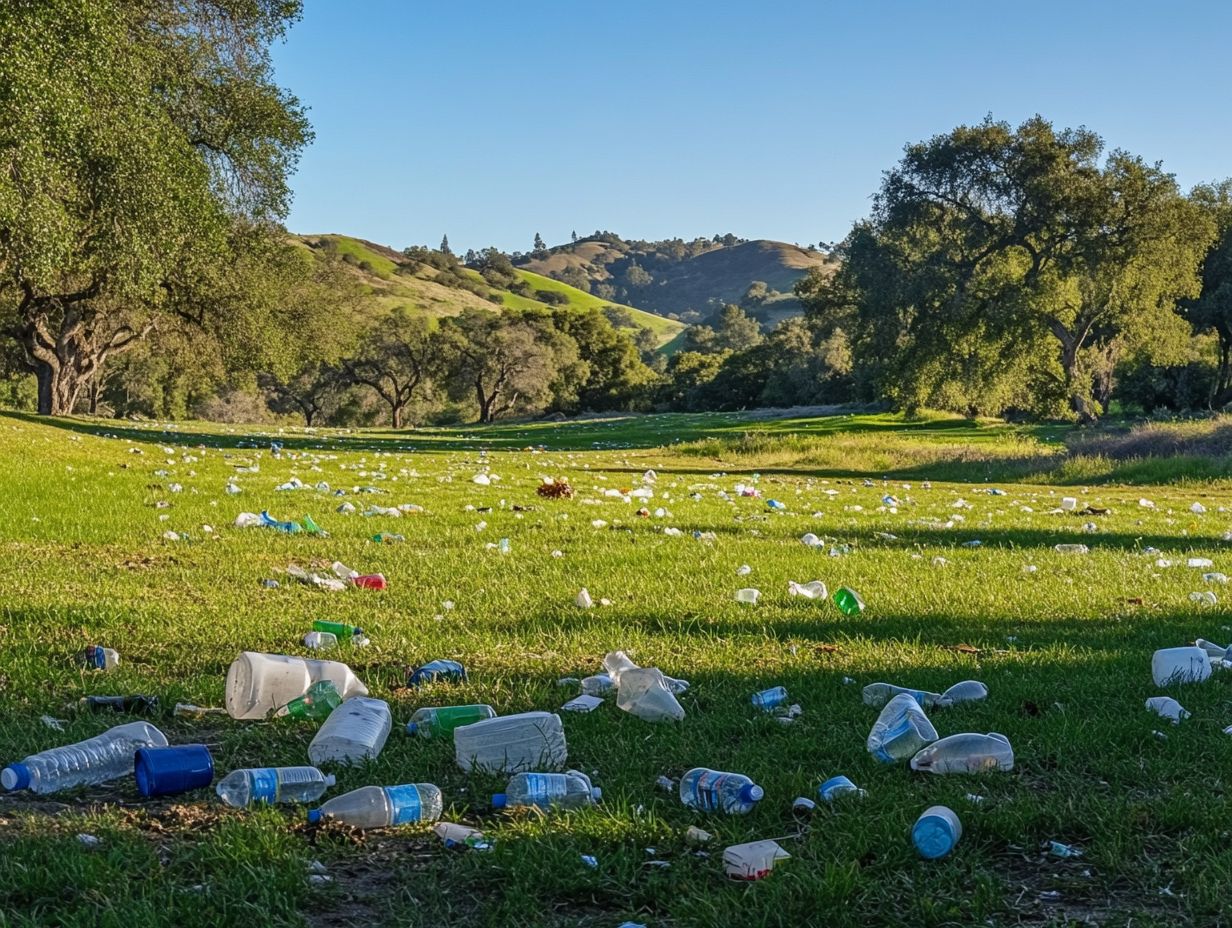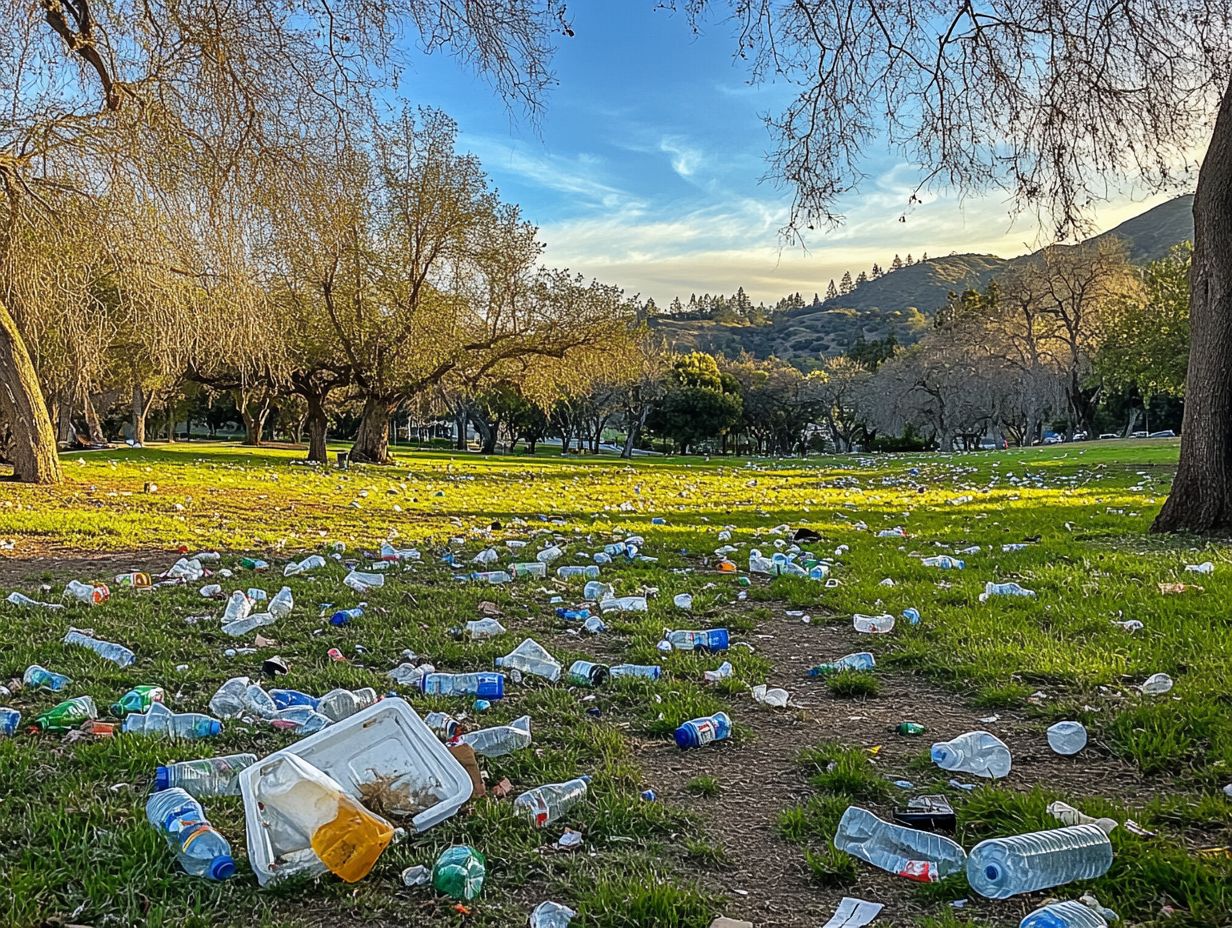Littering might appear to be a minor issue, but in Alamo, CA, its effects are anything but insignificant.
This discussion delves into the serious environmental damage caused by litter, highlighting the threats it poses to local ecosystems and wildlife.
Additionally, the social and economic repercussions are noteworthy, with increasing clean-up costs and potential negative impacts on tourism and community pride.
Let’s explore local initiatives and simple actions that individuals can take to address this pressing problem.
The Impact of Littering in Alamo, CA

Littering in Alamo, CA presents considerable challenges for both the environment and the community.
It not only diminishes the area’s visual appeal but also results in various ecological issues.
When waste is improperly disposed of, it contributes to pollution, which can negatively affect public health, wildlife, and local ecosystems.
By taking a closer look at the litter problems in Alamo, we can gain a better understanding of their environmental impact and the essential role that community involvement plays in litter reduction efforts.
This includes public awareness campaigns and educational initiatives, such as those advocated by Keep America Beautiful.
Overview of the Issue
The overview of littering issues in Alamo presents a concerning picture, characterized by various types of litter and alarming statistics that emphasize the seriousness of this escalating problem.
Single-use plastics, fast food wrappers, and cigarette butts are among the primary offenders, with reports indicating that an astonishing 30% of litter collected during local cleanup efforts can be traced back to these items.
This statistic highlights the persistent challenge residents encounter in preserving the beauty of their environment.
Current littering laws in Alamo do impose fines for littering; however, enforcement often proves inadequate, pointing to the necessity for increased community involvement.
Environmental awareness initiatives are essential in educating residents about the effects of litter on local wildlife and ecosystems.
By fostering a sense of stewardship, these initiatives not only contribute to reducing litter but also encourage a collaborative approach to community cleanup projects, enableing residents to take responsibility for their surroundings.
Environmental Effects of Littering in Alamo, CA

The environmental effects of littering are extensive, affecting local ecosystems, public health, and wildlife, with negative repercussions that resonate throughout the community.
When waste products are not disposed of properly, they contribute to pollution, turning littered areas into hotspots for harmful substances, including microplastics, that penetrate our environment.
Recognizing these effects is essential for encouraging ecological stewardship and developing effective litter prevention strategies designed to protect our natural resources.
Damage to Local Ecosystems
Littering has a significant negative impact on local ecosystems, disrupting the delicate balance of nature and posing serious threats to the wildlife that inhabits these areas.
When plastic waste becomes integrated into an ecosystem, it can be ingested by animals, leading to severe health complications and, in some cases, death.
For example, marine creatures such as seabirds and turtles often mistake plastic for food, which can obstruct their digestive systems and greatly reduce their chances of survival.
Additionally, litter introduces harmful substances into the soil and water, compromising the quality of the habitat and the availability of essential resources.
The long-term repercussions can be devastating, leading to decreased biodiversity and potentially the collapse of local species populations.
As a result, environmental protection initiatives focused on reducing litter are essential.
These efforts not only help to preserve the natural environment but also foster healthier ecosystems for future generations.
Threats to Wildlife

The threats that littering poses to wildlife are quite concerning, as many animals often mistake litter for food or become entangled in waste materials.
This can lead to severe health risks and, in some cases, even death.
Plus these immediate dangers, the long-term effects of plastic waste and microplastics infiltrating ecosystems can disrupt food chains and harm essential habitats.
Marine animals, for example, are particularly vulnerable when plastics enter ocean environments, impacting species ranging from fish to seabirds.
As a result, there is an urgent need for environmental stewardship initiatives that focus on protecting wildlife and educating communities about the consequences of littering.
By encouraging community involvement, these initiatives can effectively raise awareness and promote proactive measures to reduce litter, ultimately contributing to a healthier ecosystem and safeguarding wildlife for future generations.
Social and Economic Consequences of Littering
The social and economic consequences of littering go beyond just environmental degradation; they significantly impact community image, public health, and tourism in Alamo, CA.
The costs related to cleaning up litter can put a strain on local budgets, leading to a diversion of funds from other essential services and programs.
Moreover, littered areas can discourage tourists and foster a negative perception of the community, which in turn affects local businesses and the economy.
To address these challenges effectively, it is essential for communities to implement proactive litter solutions and promote a culture of environmental awareness.
Cost of Clean Up and Maintenance

The costs associated with cleanup and maintenance due to littering can be quite significant, often consuming valuable resources that might be better allocated to other community needs.
This financial burden does not end with immediate cleanup efforts; municipalities often find themselves investing in various waste disposal solutions.
These can include hiring sanitation crews or purchasing specialized equipment.
Additionally, the ongoing maintenance of public spaces, such as parks and streets, further complicates these expenses, diverting funds away from critical services like education and healthcare.
The presence of litter also poses considerable threats to public health, creating potential hazards that can strain local health systems.
By investing in proper waste disposal infrastructure, communities can not only reduce these financial burdens but also foster a healthier environment.
This approach ultimately protects public well-being and enhances the quality of life for residents.
Impact on Tourism and Community Image
The impact of littering on tourism and community image is significant, as areas affected by litter can discourage potential visitors and negatively shape local perceptions.
For example, well-known tourist destinations such as Venice and the beaches of Bali have experienced notable declines in visitor numbers due to unsightly litter and pollution.
Tourists typically seek clean and picturesque environments, and the presence of trash can create an impression of neglect, leading travelers to consider alternative destinations.
When communities prioritize cleanliness and cultivate a sense of pride in their surroundings, they not only attract more visitors but also strengthen their local economies.
Public awareness campaigns can play an essential role in encouraging both residents and visitors to remain mindful of their environment, thereby fostering a collective responsibility for maintaining the pristine landscapes that draw tourists in.
Addressing the Problem of Littering in Alamo, CA
Addressing the issue of littering necessitates a multifaceted approach. This includes local initiatives, community cleanup efforts, and effective strategies for litter prevention.
By working together on these fronts, we can create a cleaner and healthier environment for everyone.
Local Initiatives and Programs
Local initiatives and programs are essential in tackling littering challenges, often led by community organizations dedicated to fostering environmental stewardship.
These initiatives focus not only on the physical cleanup of public spaces but also on education and engagement to prevent littering before it starts.
For example, organizations like Keep America Beautiful mobilize local volunteers, schools, and businesses to participate in events such as the Great American Cleanup, which instills a sense of pride and responsibility within communities.
By raising awareness and providing necessary resources, these efforts encourage residents to take ownership of their environment, helping them realize that their actions directly affect their surroundings.
Public engagement is crucial; when individuals participate in cleanups and attend educational workshops, they not only contribute to cleaning their communities but also inspire their neighbors to adopt sustainable practices, creating a ripple effect of positive change.
Individual Actions to Reduce Littering in Alamo, CA
Individual actions play a crucial role in the fight against littering, as personal responsibility and community involvement can greatly reduce litter and promote proper disposal practices.
Every small step taken by an individual has the potential to create a ripple effect, encouraging others to join in the effort.
Participating in local cleanup events allows residents not only to enhance the beauty of their neighborhoods but also to inspire others to respect their environment.
Educating oneself and others about effective disposal methods—such as recycling and composting—can help foster a more environmentally conscious community.
When people come together for a shared purpose, it cultivates a culture of awareness and responsibility that can lead to meaningful, lasting change.
Ultimately, collective efforts to address litter can transform local spaces and instill a deep appreciation for nature that benefits everyone involved.
